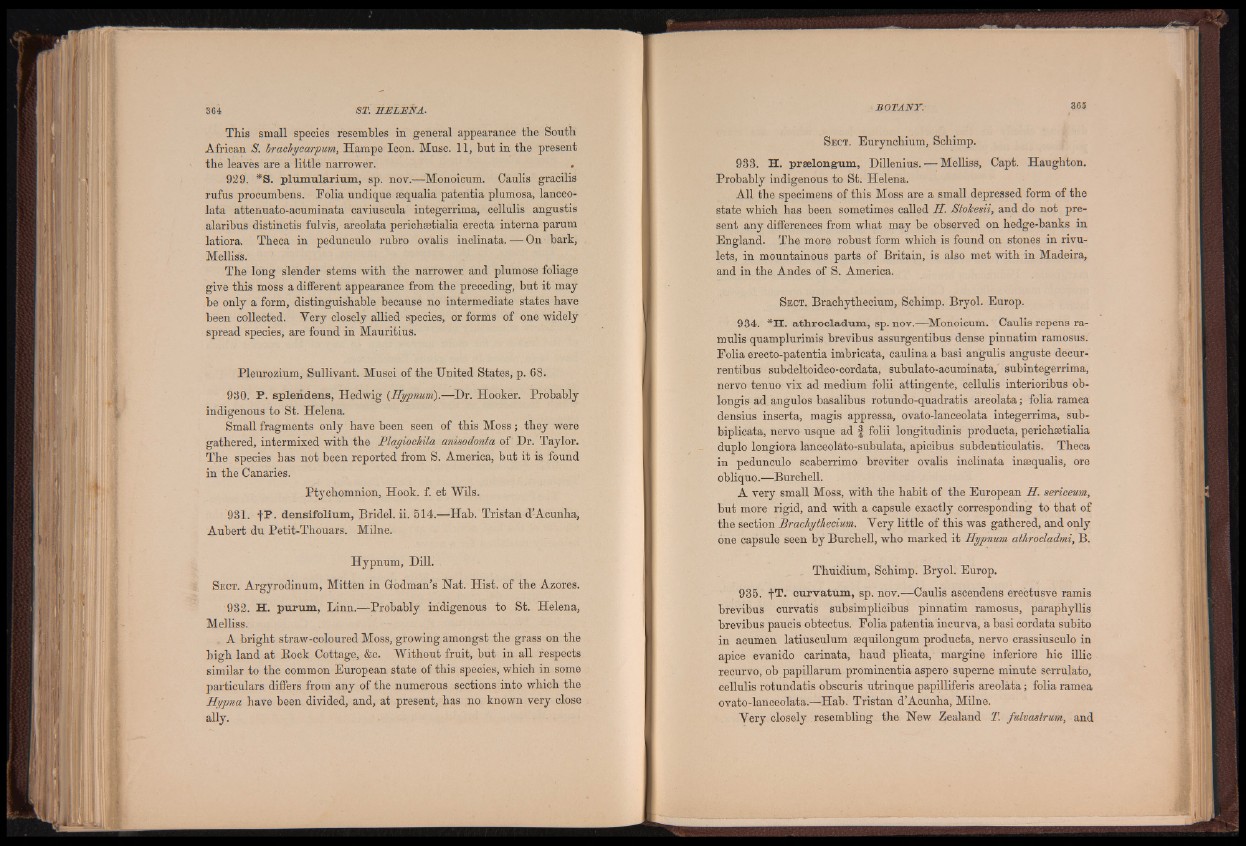
This small species resembles in general appearance the South
African S. brachycarpum, Hampe Icon. Muse. 11, hut in the present
the leaves are a little narrower.
929. *S. p l u m u l& r i u m , sp. nov.—Monoicum. Caulis gracilis
rufus procumbens. Folia undique sequalia patentia plumosa, lanceo-
lata attennato-acuminata caviuscula integerrima, cellulis angustis
alaribus distinctis fulvis, areolata perichsetialia erecta interna parum
latiora. Theca in pedunculo rubro ovalis inclinata. — On bark,
Melliss.
The long slender stems with the narrower and plumose foliage
give this moss a diiferent appearance from the preceding, but it maybe
only a form, distinguishable because no intermediate states have
been collected. Yery closely allied species, or forms of one widely
spread species, are found in Mauritius.
Pleurozium, Sullivant. Musci of the United States, p. 68.
930. P. s p l e n d e n s , Hedwig (Hypnuni).—Dr. Hooker. Probably
indigenous to St. Helena.
Small fragments only have been seen of this Moss; they were
gathered, intermixed with the Playiockila anisodonta of Dr. Taylor.
The species has not been reported from S. America, but it is found
in the Canaries.
Ptychomnion, Hook. f. et Wils.
931. -f-P. d e n s i f o l i u m , Bridel. ii. 514.—Hab. Tristan d’Acunha,
Aubert du Petit-Thouars. Milne.
Hypnnm, Dill.
S e c t . Argyrodinum, Mitten in Grodman’s Hat. Hist, of the Azores.
932. H. p u r u m , Linn.—Probably indigenous to St. Helena,
Melliss.
A bright straw-coloured Moss, growing amongst the grass on the
high land at Eock Cottage, &c. "Without fruit, but in all respects
similar to the common European state of this species, which in some
particulars differs from any of the numerous sections into which the
Hypna have been divided, and, at present, has no known very close
S e c t . Eurynchium, Schimp.
933. H. prselongum, Dillenius. — Melliss, Capt. Haughton.
Probably indigenous to St. Helena.
All the specimens of this Moss are a small depressed form of the
state which has been sometimes called H. Stolcesii, and do not present
any differences from what may be observed on hedge-banks in
England. The more robust form which is found on stones in rivulets,
in mountainous parts of Britain, is also met with in Madeira,
and in the Andes of S. America.
S e c t . Brachythecium, Schimp. Bryol. Europ.
934. *H. athrocladum, sp. nov.—Monoicum. Caulis repens ra-
mulis quamplurimis brevibus assurgentibus dense pinnatim ramosus.
Folia erecto-patentia imbricata, caulina a basi angulis anguste decur-
rentibus subdeltoideo-cordata, subulato-acuminata, subintegerrima,
nervo tenuo vix ad medium folii attingente, cellulis interioribus ob-
longis ad angulos basalibus rotundo-quadratis areolata; folia ramea
densius inserta, magis appressa, ovato-lanceolata integerrima, sub-
biplicata, nervo usque ad | folii longitudinis producta, perichsetialia
duplo longiora lanceolato-subulata, apicibus subdenticulatis. Theca
in pedunculo scaberrimo breviter ovalis inclinata inseqnalis, ore
obliquo.—Burchell.
A very small Moss, with the habit of the European H. sericeum,
but more rigid, and with a capsule exactly corresponding to that of
the section Brachythecium.. Yery little of this was gathered, and only
one capsule seen by Burchell, who marked it Hypnum athrocladmi, B.
Thuidium, Schimp. Bryol. Europ.
935. fT. curvatum, sp. nov.—Caulis ascendens erectusve ramis
brevibus curvatis subsimplicibus pinnatim ramosus, paraphyllis
brevibus paucis obtectus. Folia patentia incurva, a basi cordata subito
in acumen latiusculum sequilongum producta, nervo crassiusculo in
apice evanido carinata, haud plicata, margine inferiore hie illic
recurvo, ob papillarum prominentia aspero superne minute serrulato,
cellulis rotundatis obscuris utrinque papilliferis areolata; folia ramea
ovato-lanceolata.—Hab. Tristan d’Acunha, Milne.
Yery closely resembling the New Zealand T. fulvastrum, and